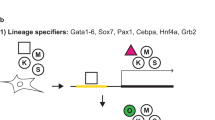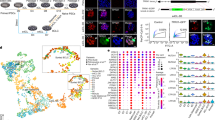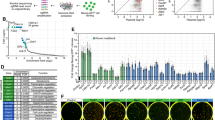Abstract
Induced pluripotent stem (iPS) cells can be obtained by the introduction of defined factors into somatic cells1. The combination of Oct4 (also known as Pou5f1), Sox2 and Klf4 (which we term OSK) constitutes the minimal requirement for generating iPS cells from mouse embryonic fibroblasts. These cells are thought to resemble embryonic stem cells (ESCs) on the basis of global gene expression analyses; however, few studies have tested the ability and efficiency of iPS cells to contribute to chimaerism, colonization of germ tissues, and most importantly, germ-line transmission and live birth from iPS cells produced by tetraploid complementation. Using genomic analyses of ESC genes that have roles in pluripotency and fusion-mediated somatic cell reprogramming, here we show that the transcription factor Tbx3 significantly improves the quality of iPS cells. iPS cells generated with OSK and Tbx3 (OSKT) are superior in both germ-cell contribution to the gonads and germ-line transmission frequency. However, global gene expression profiling could not distinguish between OSK and OSKT iPS cells. Genome-wide chromatin immunoprecipitation sequencing analysis of Tbx3-binding sites in ESCs suggests that Tbx3 regulates pluripotency-associated and reprogramming factors, in addition to sharing many common downstream regulatory targets with Oct4, Sox2, Nanog and Smad1. This study underscores the intrinsic qualitative differences between iPS cells generated by different methods, and highlights the need to rigorously characterize iPS cells beyond in vitro studies.
This is a preview of subscription content, access via your institution
Access options
Subscribe to this journal
Receive 51 print issues and online access
$199.00 per year
only $3.90 per issue
Buy this article
- Purchase on Springer Link
- Instant access to full article PDF
Prices may be subject to local taxes which are calculated during checkout




Similar content being viewed by others
Accession codes
Primary accessions
Gene Expression Omnibus
Data deposits
All microarray and sequencing data are available from the Gene Expression Omnibus database (http://www.ncbi.nlm.nih.gov/geo) under accession codes GSE19164 and GSE19219.
References
Takahashi, K. & Yamanaka, S. Induction of pluripotent stem cells from mouse embryonic and adult fibroblast cultures by defined factors. Cell 126, 663–676 (2006)
Huangfu, D. et al. Induction of pluripotent stem cells by defined factors is greatly improved by small-molecule compounds. Nature Biotechnol. 26, 795–797 (2008)
Shi, Y. et al. Induction of pluripotent stem cells from mouse embryonic fibroblasts by Oct4 and Klf4 with small-molecule compounds. Cell Stem Cell 3, 568–574 (2008)
Silva, J. et al. Promotion of reprogramming to ground state pluripotency by signal inhibition. PLoS Biol. 6, e253 (2008)
Okita, K., Nakagawa, M., Hyenjong, H., Ichisaka, T. & Yamanaka, S. Generation of mouse induced pluripotent stem cells without viral vectors. Science 322, 949–953 (2008)
Daley, G. Q. et al. Broader implications of defining standards for the pluripotency of iPSCs. Cell Stem Cell 4, 200–201 (2009)
Feng, B. et al. Reprogramming of fibroblasts into induced pluripotent stem cells with orphan nuclear receptor Esrrb. Nature Cell Biol. 11, 197–203 (2009)
Marson, A. et al. Wnt signaling promotes reprogramming of somatic cells to pluripotency. Cell Stem Cell 3, 132–135 (2008)
Wernig, M. et al. In vitro reprogramming of fibroblasts into a pluripotent ES-cell-like state. Nature 448, 318–324 (2007)
Chin, M. H. et al. Induced pluripotent stem cells and embryonic stem cells are distinguished by gene expression signatures. Cell Stem Cell 5, 111–123 (2009)
Mitsui, K. et al. The homeoprotein Nanog is required for maintenance of pluripotency in mouse epiblast and ES cells. Cell 113, 631–642 (2003)
Silva, J., Chambers, I., Pollard, S. & Smith, A. Nanog promotes transfer of pluripotency after cell fusion. Nature 441, 997–1001 (2006)
Tam, W. L. et al. T-cell factor 3 regulates embryonic stem cell pluripotency and self-renewal by the transcriptional control of multiple lineage pathways. Stem Cells 26, 2019–2031 (2008)
Ivanova, N. et al. Dissecting self-renewal in stem cells with RNA interference. Nature 442, 533–538 (2006)
Hotta, A. & Ellis, J. Retroviral vector silencing during iPS cell induction: an epigenetic beacon that signals distinct pluripotent states. J. Cell. Biochem. 105, 940–948 (2008)
Eakin, G. S. & Hadjantonakis, A. K. Production of chimeras by aggregation of embryonic stem cells with diploid or tetraploid mouse embryos. Nature Protocols 1, 1145–1153 (2006)
Ohta, H., Sakaide, Y., Yamagata, K. & Wakayama, T. Increasing the cell number of host tetraploid embryos can improve the production of mice derived from embryonic stem cells. Biol. Reprod. 79, 486–492 (2008)
Chen, X. et al. Integration of external signaling pathways with the core transcriptional network in embryonic stem cells. Cell 133, 1106–1117 (2008)
Wernig, M. et al. A drug-inducible transgenic system for direct reprogramming of multiple somatic cell types. Nature Biotechnol. 26, 916–924 (2008)
Yu, J. et al. Induced pluripotent stem cell lines derived from human somatic cells. Science 318, 1917–1920 (2007)
Loh, Y. H. et al. The Oct4 and Nanog transcription network regulates pluripotency in mouse embryonic stem cells. Nature Genet. 38, 431–440 (2006)
Zhang, J. et al. Sall4 modulates embryonic stem cell pluripotency and early embryonic development by the transcriptional regulation of Pou5f1. Nature Cell Biol. 8, 1114–1123 (2006)
Reynolds, A. et al. Rational siRNA design for RNA interference. Nature Biotechnol. 22, 326–330 (2004)
Chua, S. W. et al. A novel normalization method for effective removal of systematic variation in microarray data. Nucleic Acids Res. 34, e38 (2006)
Jiang, J. et al. A core Klf circuitry regulates self-renewal of embryonic stem cells. Nature Cell Biol. 10, 353–360 (2008)
Acknowledgements
This work is supported by the Agency for Science, Technology and Research (Singapore) and the Singapore Stem Cell Consortium grant (SSCC-06-003). The work is also partially supported by National Institutes of Health (NIH) grants to B.L. (DK047636 and AI54973). W.-L.T. is supported by the A*STAR Post-doctoral Fellowship. We acknowledge the Genome Technology and Biology group for technical support. We are grateful to T. Huber, P. Robson and L. Stanton for critical comments, V. Cacheux-Rataboul for karyotype analyses, Y. Loon Lee, P. Gaughwin and colleagues from the Stem Cell and Developmental Biology group for technical assistance. We also thank T. Wakayama and N. Li for imparting mouse embryo manipulation techniques.
Author Contributions J.H., W.-L.T. and B.L. conceptualized and designed the experiments; J.H. and W.L.T. performed most of the experiments and analysed the data; P.Y. and J.Z. performed molecular cloning and ChIP experiments; S.L.L. performed Southern hybridizations; J.T., P.L. and S.C. assisted with cell culture and mouse embryo manipulation; B.S.S. performed microarray and quantitative PCR measurements; H.Y. and Y.L.O. performed bioinformatics analyses; T.L. and H.-H.N. analysed the data and commented on the manuscript. W.L.T. and B.L. conceived the study and wrote the manuscript.
Author information
Authors and Affiliations
Corresponding authors
Supplementary information
Supplementary Information
This file contains Supplementary Figures 1-19 with Legends, Supplementary Methods and Supplementary References. (PDF 4575 kb)
Supplementary Table 1
This table shows genes upregulated in Nanog over-expressing ESCs. (XLS 1967 kb)
Supplementary Table 2
This table shows genes upregulated in Tcf3 RNAi ESCs. (XLS 2269 kb)
Supplementary Table 3
This table shows genes downregulated in Tbx3 RNAi ESCs. (XLS 11573 kb)
Supplementary Table 4
This table shows genes upregulated in Nanog OE ESC/MEF hybrids. (XLS 1455 kb)
Supplementary Table 5
This table shows genes upregulated in Tcf3 RNAi ESC/MEF hybrids. (XLS 2247 kb)
Supplementary Table 6
This table shows Tbx3 bound sites obtained by Solexa sequencing (of tags 7 and above). (XLS 273 kb)
Supplementary Table 7
This table shows summary of iPS clone ID and analyses performed on these clones. (XLS 33 kb)
Rights and permissions
About this article
Cite this article
Han, J., Yuan, P., Yang, H. et al. Tbx3 improves the germ-line competency of induced pluripotent stem cells. Nature 463, 1096–1100 (2010). https://doi.org/10.1038/nature08735
Received:
Accepted:
Published:
Issue Date:
DOI: https://doi.org/10.1038/nature08735
This article is cited by
-
Rhox6 regulates the expression of distinct target genes to mediate mouse PGCLC formation and ESC self-renewal
Cell & Bioscience (2023)
-
Expression of Chrna9 is regulated by Tbx3 in undifferentiated pluripotent stem cells
Scientific Reports (2023)
-
A multi-omics integrative analysis based on CRISPR screens re-defines the pluripotency regulatory network in ESCs
Communications Biology (2023)
-
Investigating neural differentiation of mouse P19 embryonic stem cells in a time-dependent manner by bioinformatic, microscopic and transcriptional analyses
Molecular Biology Reports (2023)
-
Heritable genomic diversity in breast cancer driver genes and associations with risk in a Chilean population
Biological Research (2022)
Comments
By submitting a comment you agree to abide by our Terms and Community Guidelines. If you find something abusive or that does not comply with our terms or guidelines please flag it as inappropriate.



